Regal pelargoniums (botanical name: Pelargonium grandiflorum) are among the most elegant of ornamental plants. On the balcony, patio or in the living room, they add a splash of colour and are remarkably easy to care for. This article will tell you all you need to know about their origins, care and uses.
Key facts
What are regal pelargoniums and what do they look like?
Regal pelargoniums are low-maintenance ornamental plants with large, velvety flowers and compact growth. They originate from South Africa and were originally grown as indoor plants. Today they are also a pretty seasonal plant for balconies and patios.
How should I care for regal pelargoniums?
Location: Bright, both indoors and outdoors; outdoors also sheltered from wind and rain.
Watering: Keep soil evenly moist, avoid waterlogging.
Fertilising: Every two weeks during flowering from March to October.
Special considerations: Regal Pelargoniums are not frost hardy. In the UK they are also known as simply peralgonium.
Table of contents
- Key facts
- Origins of regal pelargoniums
- Magnificent flowers
- The ideal location
- Regal pelargoniums as houseplants
- Decorating with regal pelargoniums
- Quality criteria when buying regal pelargoniums
- The right compost
- Watering and fertilising
- How to overwinter successfully
- Regal pelargonium propagation
- FAQs on regal pelargoniums
- Glossary
Origins of regal pelargoniums
Regal pelargoniums (Pelargonium grandiflorum), also known as simply pelargoniums, are native to the Cape region of South Africa. In their natural habitat they grow between rocks and in scrubland, and are hardy and perfectly adapted to the sunny, dry climate. In the 18th century, Dutch sailors brought the first plants to Europe, where a new chapter in the history of the regal pelargonium began. European botanists and gardeners were fascinated by their growth habit and flowers. They began to cross them to produce more intense colours and more beautiful flowers.
In the 19th century, England became the centre of pelargonium cultivation. Particularly during the Victorian era, the plant from the Cape was seen as a status symbol – the more exotic and colourful the flowers, the higher the social status of the owner.
A plant with regal charm
‘Regal’ means royal, and this is exactly the impression the plant gives with its magnificent, imposing, flowers. The royal charm of the regal pelargonium is not only appreciated in England and Germany. The Dutch affectionately call them ‘Franse Geranium’ or ‘French Geranium’. The reference to France here stands for ‘grandeur’ – a term that describes majesty, splendour and size. And these characteristics are reflected in the appearance of the regal pelargonium: its large, magnificent flowers – hence the botanical name ‘grandiflorum’, which means ‘large flower’ – make it a plant that brings truly regal elegance to any room, garden or balcony.
Did you know? The original South African wild species still play a role in breeding programmes today. They bring new colours and hardiness to modern hybrids, so regal pelargoniums can now be grown outdoors in sheltered areas in some countries. They are actually beautiful houseplants.
Magnificent flowers
The flowers of regal pelargoniums are grouped on long stems and are remarkable for their size (individual flowers can reach up to 5cm in diameter), intensity of colour and velvety surface. This texture is reminiscent of fine fabric and makes the regal pelargonium the queen of geraniums. Flower colours range from white through classic red and bright pink to violet and delicate pastels. Some varieties have unusual bicoloured flowers or striking patterns that appear painted on, and many have a dark eye in the centre.
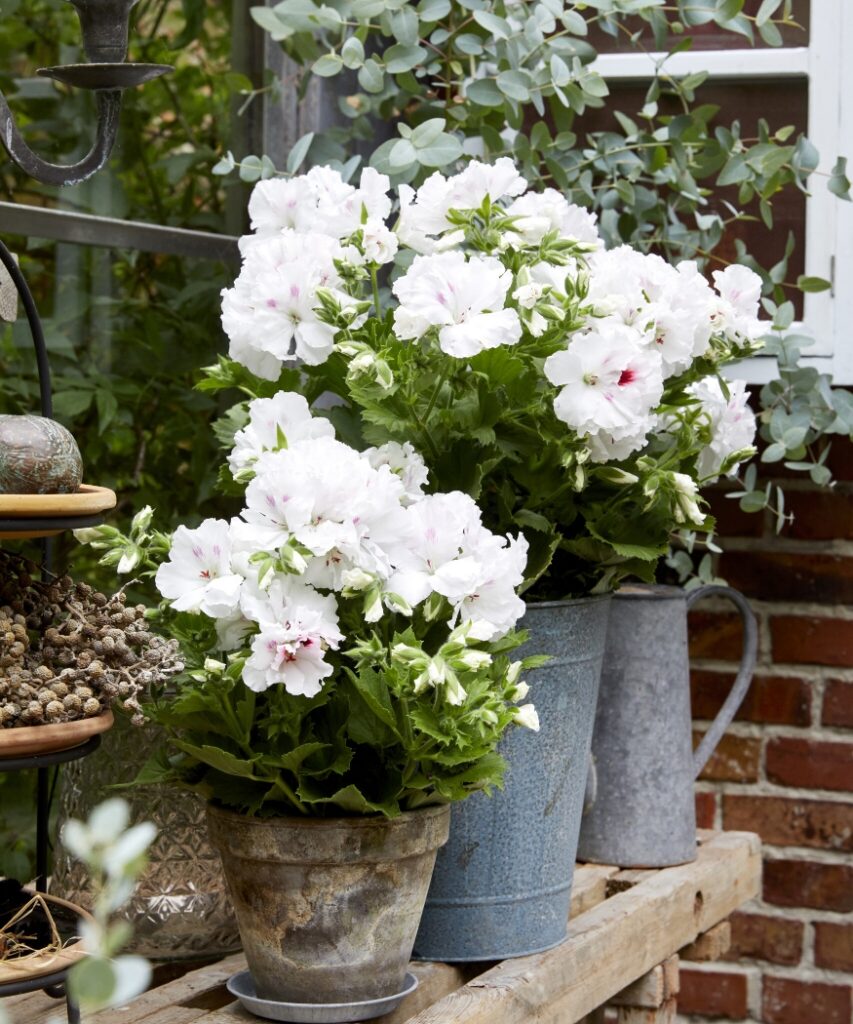
Varieties with dark veins on the petals are especially popular. The outstanding beauty of regal pelargoniums is the result of careful breeding. Attention is paid not only to large and decorative flowers, but also to vigorous flowering and hardiness. Modern regal pelargoniums are bred to flower continuously from spring to autumn. The first flowering specimens are available from March.
Did you know? The velvety surface of the petals originally served as a protective mechanism in the plant kingdom. It reduces evaporation and helps retain moisture – a practical advantage for plants that originate in the dry climate of South Africa.
The ideal location
Regal pelargoniums love a bright location and thrive best in four to six hours of direct sunlight a day (sunny location). However, they will grow well in partial shade (semi-shaded position). Temperatures below 10°C, strong winds and heavy rain are damaging, as their large petals are easily damaged. A sheltered position, such as under a balcony or on a covered patio, is ideal. Thanks to their South African origins, they tolerate heat well.
Tip: If your regal pelargoniums are on an unprotected balcony or in an exposed spot in the garden, move them indoors temporarily during extreme weather. This will protect the plants, extend their flowering period and keep them healthy. Or use them for indoor display instead.
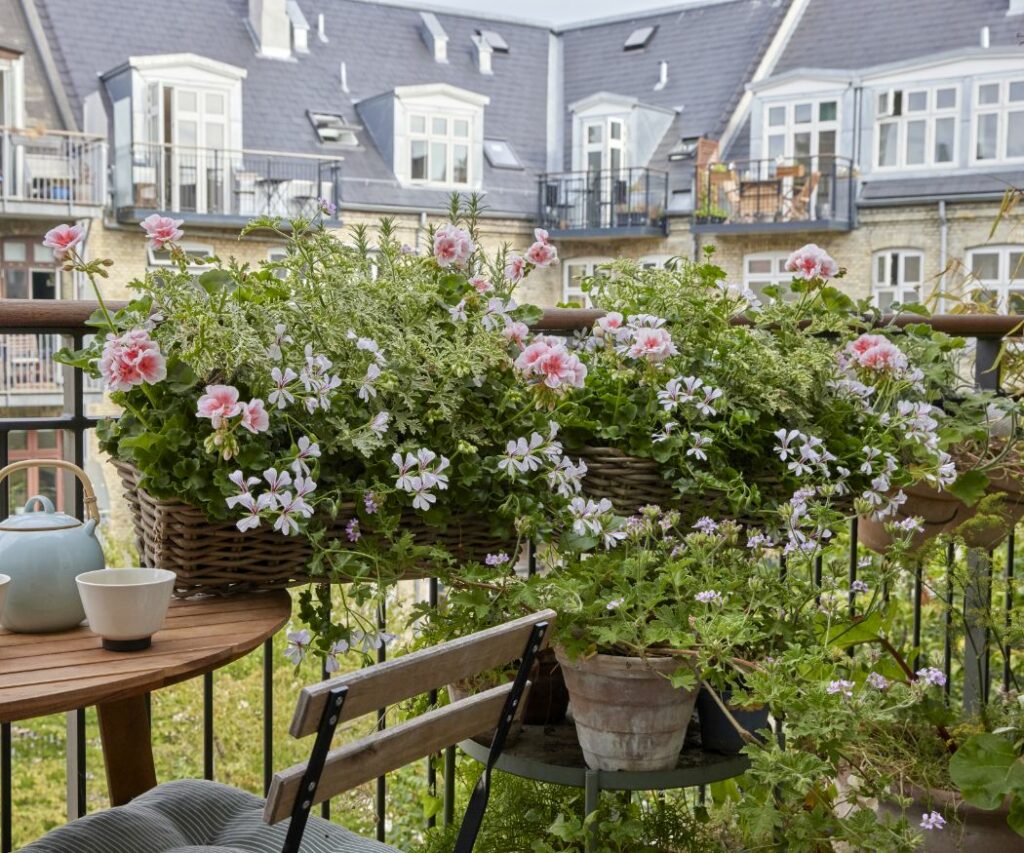
Regal pelargoniums in partial shade: That works too!
Attention regal pelargonium lovers! We’ll show you how to grow your own regal pelargoniums in partial shade and produce stunning flowers that will brighten up your life. No green fingers required. Read on to find out how to do it.
Regal pelargoniums as houseplants
Not everyone has a balcony or garden, and this is where regal pelargoniums come into their own. They make fantastic houseplants – provided they get enough light indoors. A bright spot is ideal. There they can bring a splash of colour to your home. Indoors they even have some advantages: Unlike outdoors, they are protected from wind, rain and extreme temperature fluctuations. But beware: although this pretty plant loves light, direct sunlight in south-facing windows can lead to heat build-up in high summer. A slightly shaded window or a bright spot facing east or west with plenty of fresh air is often better.
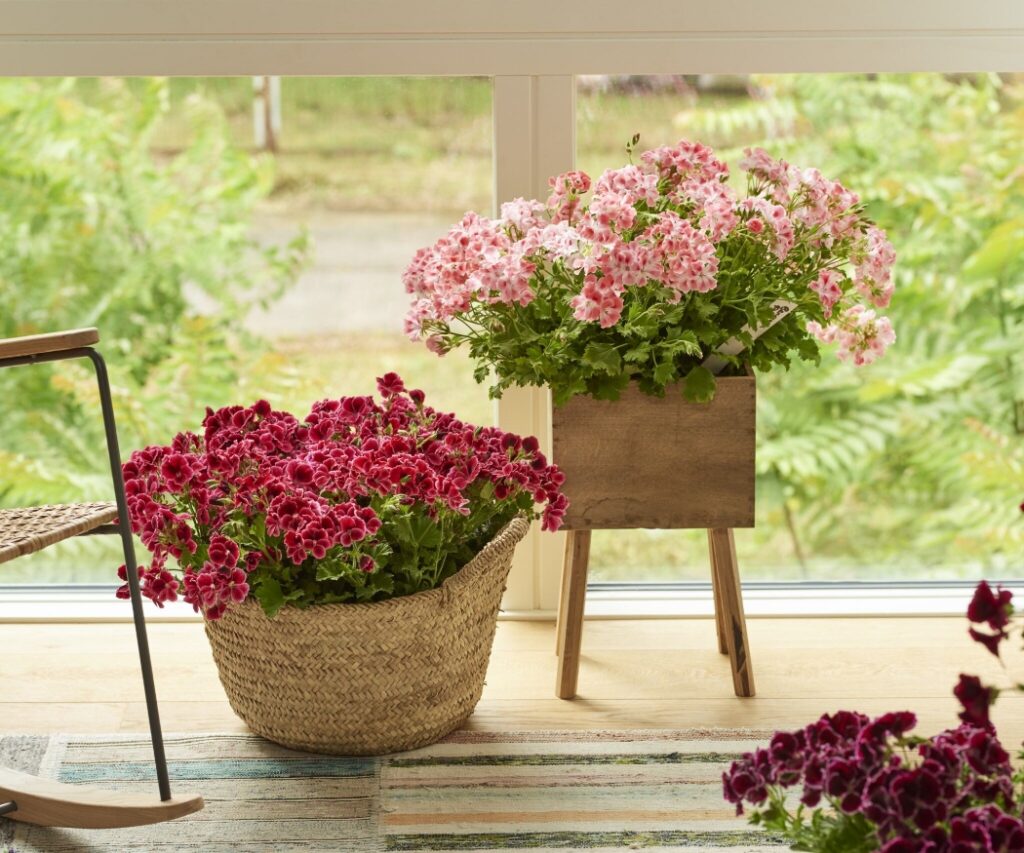
Tip: As well as being visually stunning, indoor pelargoniums are surprisingly easy to maintain. Regular watering and fertilising every fortnight or so will encourage vigorous flowering and keep them looking their best.
➡️ Fancy a creative craft project? Then why not try making a homemade pot for your geraniums? Take a look at the example on our Instagram profile mygeranium and be inspired!
Decorating with regal pelargoniums
Regal pelargoniums are born stars. Their impressively large flowers and upright growth make them a real showstopper that will delight you all summer long. They don’t need other plants with them to shine. Whether in a stylish pot, as a table display, on a plant stand or windowsill, they will grace any setting and add a splash of colour both indoors and out. With their intense shades, velvety flowers and elegant foliage, regal pelargoniums look like works of art without the need to combine them with other plants.
Tip: Regal pelargoniums really come into their own in minimalist or modern garden and interiors. Try it out! Of course, they can embellish a romantic, rural or elegant setting too. Not to mention they can also create a wonderful vintage feel – a plant for all occasions! Regal pelargoniums are available in many different sizes, even as a standard plant on a long stem.

Looking for a summer decoration idea for your patio?
How about a homemade regal pelargonium table wreath? Watch our video and learn step-by-step how to make a beautiful regal pelargonium table wreath:
Homemade geranium table wreaths – a summer idea for your patio.
Quality criteria when buying regal pelargoniums
When buying regal pelargoniums it’s worth looking carefully at them. The quality of the plant will determine how well it develops and how long it will flower.
How to spot a quality regal pelargonium:
– Healthy leaves
– Strong shoots
– Visible buds
– Free from pests
If possible, buy your regal pelargoniums from a local nursery or specialist garden centre. Not only will you often get stronger plants, but also practical care instructions.
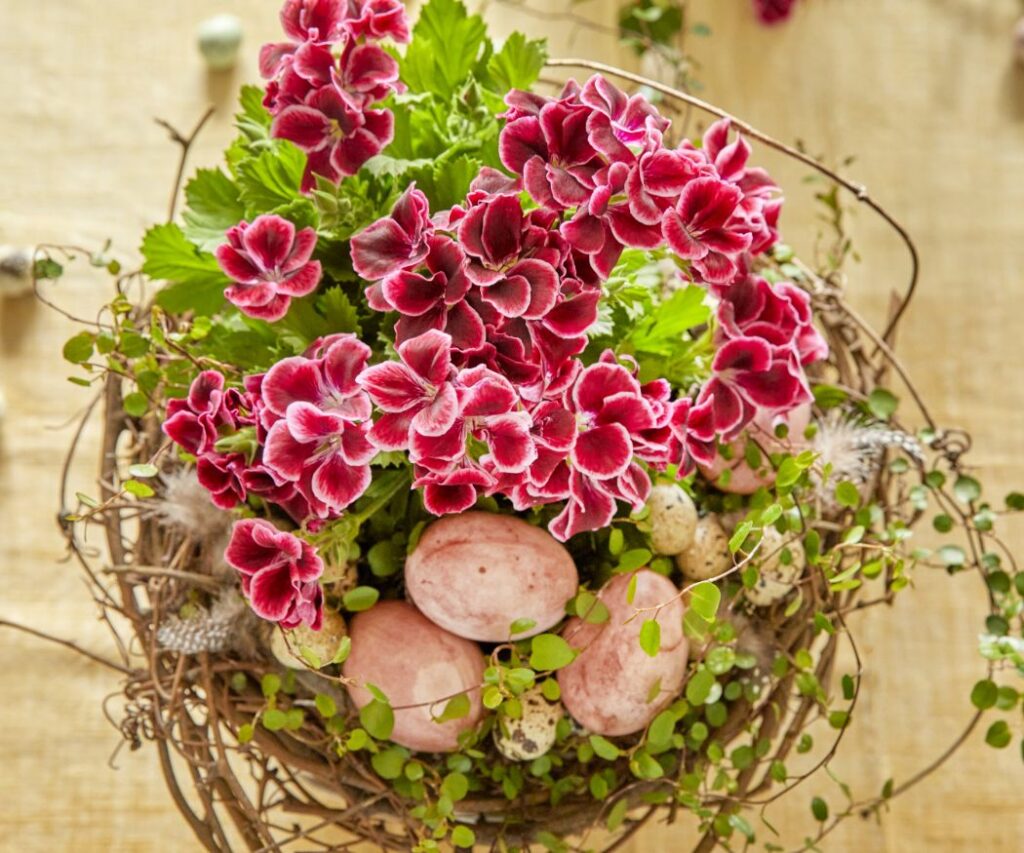
Tip: The best time to buy regal pelargoniums is in spring. The first ones are available from March. These early varieties make excellent houseplants and eye-catching Easter decorations. In early May (around Mother’s Day in many European countries) there is a huge choice of varieties. From mid-May onwards you can plant them outdoors in a sheltered spot if you wish.
➡️ Find out how to create a magical Easter decoration with just a few simple tools. Check out the Instagram post here and start your next craft project: Easter Decoration Ideas on Instagram. Happy crafting and Happy Easter!
The right compost
The right soil is very important for vigorous growth and a long flowering period. A specialist geranium compost is best, as it’s loose and nutrient-rich, holds water well and allows excess moisture to drain quickly. This is ideal for regal pelargoniums, which need regular watering but are sensitive to being waterlogged.
Tip: Use a pot with drainage holes when repotting or replanting. A layer of expanded clay in the bottom of the container will help prevent waterlogging and give your regal pelargoniums the best possible conditions.
Watering and fertilising
Watering correctly: not too much and not too little
Regal pelargoniums prefer evenly moist soil. Avoid waterlogging at all times. Water the plants as soon as the top layer of compost is slightly dry. To check this, push your finger about 2-3cm into it. If it feels dry and warm, it’s time to water. If it’s cool and moist, watering can wait. On hot days you may need to water daily, while in cooler periods you may not need to water as often. Use lukewarm water and make sure that no moisture remains in the drip tray after watering.
Fertiliser: for continued flowering
How often? Weekly, from March to September.
Which type? Liquid fertilisers are the most practical, as you can simply add them to the water when watering. Alternatively, use slow-release fertilisers to provide nutrients to plants over several weeks or months. Mix it into the compost when you plant.
Tip: If your regal pelargoniums are in partial shade, they will need slightly less water and nutrients than in full sun. Adjust the amount of water and fertiliser by about 10 per cent and keep an eye on its growth.
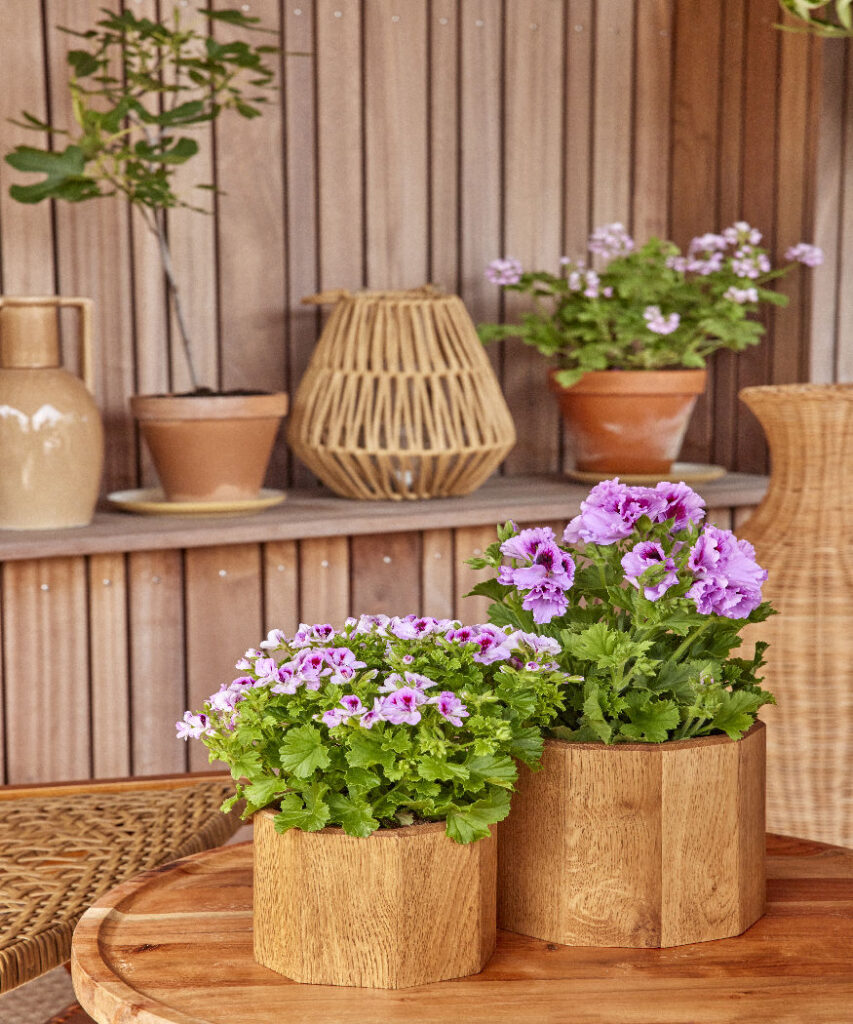
Watering geraniums
Find out all you need to know about watering geraniums – from the 10% rule to the best times to water. The experts at Pelargonium for Europe have put together all the information you need on fertilising geraniums.
Deadheading and pruning
To keep regal pelargoniums blooming throughout the summer, deadheading is a must. This small maintenance measure ensures the plant puts its energy into producing new flowers rather than seed formation. Faded flowers are best removed with your fingers or cut off with sharp scissors. Don’t just snip off the flower, remove the entire stem.
Pruning in summer
If your regal pelargoniums start to look a little out of shape in the summer, light pruning is a good idea. Cut back any shoots that are too long or overhanging. This will encourage the plant to grow more compact and produce new flowers. Shoots with fresh flowers still attached can be used as cut flowers for pretty decorations.
Pruning and deadheading may sound time-consuming, but they are quick and make a big difference: well-maintained regal pelargoniums not only flower longer, they are also much stronger.
How to overwinter successfully
Regal pelargoniums are perennials, which means you can make them flower again and again. You can expect abundant flowering for up to three years. After that pelargoniums will grow old and flower less profusely. In autumn, after flowering and as soon as it regularly gets colder than 10°C outside, they should be moved to their winter home.
The ideal winter home
Regal pelargoniums overwinter differently to zonal or trailing balcony pelargoniums. A bright room is ideal. For example, an unheated conservatory, a cool stairwell or a bright basement window. Temperatures between 10-15°C are best. The warmer it is, the more light they need.
How to prepare your regal pelargoniums for winter
Cut back the plant’s shoots by about a third. Also remove wilted leaves and faded flowers to prevent diseases. Over the winter, it can remain in the same pot it was in during the summer. If your regal pelargoniums are infested with pests such as aphids or spider mites, it’s not worth overwintering them.
Care during winter
Keep the soil slightly moist, but not wet. Regal pelargoniums need considerably less water in winter. A bright location will encourage vigorous growth. It is best to place them in a window.
A new start in spring
In March it’s time to bring your royal pelargoniums out of their winter hibernation. Repot them in fresh geranium compost or give them new slow-release fertiliser and cut off any dead shoots. Gradually acclimatise them to more light and warmth. Once temperatures are consistently above 10°C, you can move them outdoors again. They will make lovely houseplants until then.
Pro tip on flower formation

Pelargonium grandiflorum, the regal pelargonium, is day-neutral. This means that it can flower regardless of day length. Long days – those with lots of light – can speed up flowering, so give your plant plenty of light if you are impatient to see its large, magnificent flowers.
Regal pelargonium propagation
• Choose healthy, strong shoots that are not flowering.
• Take the cutting just below a leaf node.
• Remove the lower leaves so only one or two pairs of leaves remain on the cutting.
• Place the cutting in cultivationn compost. Gently press the soil around it to make it stable.
• Keep the soil slightly moist, but not wet.
• Place the cutting in a bright spot, but not in direct sunlight, at around 20°C (68°F).
• The first roots should appear after two to three weeks. The cutting will then begin to produce new leaves.
• Once the plants have grown, transplant them into a larger pot with normal geranium compost. Suche dir gesunde und kräftige Triebe aus, die keine Blüten tragen.
Late summer or early autumn is ideal for propagating regal pelargoniums by cuttings. At this time, the plants are vigorous and the young shoots will root well.
FAQs on regal pelargoniums
How do I care for regal pelargoniums?
Regal pelargoniums need a bright, sheltered location away from wind and rain, and regular care. Make sure they are watered evenly without waterlogging. Feed every one to two weeks during the growing and flowering season. Remove dead blooms regularly to encourage new ones. Regal pelargoniums are popular houseplants if given a bright enough position.
When/how long do regal pelargoniums bloom for?
Under optimum conditions, fresh regal pelargoniums will flower from March to October. Regular fertilising, watering and removal of faded blooms is the key to long flowering.
Which compost is best for regal pelargoniums?
Loose, nutrient-rich geranium compost with good water retention and drainage is ideal.
How do I encourage regal pelargoniums to flower?
Remove faded flowers regularly and fertilise the plant every one to two weeks to encourage new buds.
What is the difference between geraniums and regal pelargoniums?
Regal pelargoniums have larger and more showy flowers. In contrast to zonal and hanging geraniums (Pelargonium zonale or Pelargonium peltatum), they are suitable as houseplants.
Are regal pelargoniums for indoors or outdoors?
Regal pelargoniums (Pelargonium grandiflorum) are versatile plants that will thrive both indoors and outdoors.
Can regal pelargoniums stay outside in winter? Are they hardy?
No, regal pelargoniums are not hardy. Bring them indoors before the first frost. A bright, cool room at 10-15°C is perfect for overwintering them.
How often should I water regal pelargoniums?
Water your regal pelargoniums as soon as the top layer of soil is dry (finger test). This may need to be done daily during the hot summer months. During the winter dormancy period they will need much less water.
Are regal pelargoniums suitable for partial shade?
Yes, regal pelargoniums can be grown in partial shade. They will flower a little less than in full sun but will remain healthy and vigorous. A position in full shade is not suitable.
What should I do if my regal pelargoniums aren’t flowering?
When regal pelargoniums fail to flower, it’s usually due to lack of nutrients or too little light. Plants that are several years old will also lose their ability to flower. Move your regal pelargoniums to a sunnier spot and feed them regularly. Deadhead any faded flowers to encourage new buds. Replace plants that have overwintered several times with new ones.
The leaves of my regal pelargoniums are turning yellow. What’s causing this?
Yellow leaves on regal pelargoniums can be caused by a number of things. Make sure you’re giving the correct care to eliminate the cause.
- Overwatering: Too much water often leads to root rot, which can cause the leaves to turn yellow. Make sure the water can drain well and allow the top layer to dry out between waterings.
- Nutritional deficiencies: A lack of essential nutrients, such as nitrogen, can cause yellowing. Fertilising will help to remedy this.
- Cold: Regal pelargoniums don’t like cold. If they’re placed in a room that’s too cold or exposed to draughts in winter, the leaves may turn yellow.
- Lack of light: Too little light can also cause yellow leaves. Move the plant to a bright spot.
- Pests: Aphids or other pests can also cause yellowing. Check the plant for pests and treat if necessary.
My regal pelargoniums are shedding flowers. What is causing this?
Regal pelargoniums will lose their flowers as they fade. This is a natural process. Remove wilted blooms to encourage the plant to produce new ones. Flower formation can also be affected by care errors such as too little light, incorrect watering or lack of nutrients.
Do snails like regal pelargoniums?
Regal pelargoniums are not particularly attractive to snails. As long as there is other food available, they will give the hairy leaves a wide berth.
Are regal pelargoniums safe for pets?
The Institute of Veterinary Pharmacology and Toxicology at the University of Zurich lists the regal pelargonium (Pelargonium grandiflorum) in its database as a non-toxic plant (not a poisonous plant). No cases of animal poisoning have been reported in the relevant literature. However, regal pelargoniums should not be fed to pets.
Where can I buy regal pelargoniums?
Regal pelargoniums are available from local nurseries or garden centres. The best time to buy them is in spring. Look for healthy plants with strong leaves and lots of buds.
Are regal pelargoniums easy to look after?
Yes, regal pelargoniums are easy to look after. In a bright, sheltered spot, with regular watering and a little fertiliser, they will thrive and flower for months.
Are regal pelargoniums bee-friendly plants/good for bees?
Scented geraniums are actually more bee-friendly, but some regal pelargoniums also contain some pollen and sometimes nectar in their stamens.
What are the sustainability benefits of regal pelargoniums for the eco-conscious gardener?
Regional cultivation: Regal pelargoniums are grown regionally to the latest standards. This not only boosts the local economy but also minimises transport and CO2 emissions.
Water requirements: They require only moderate watering and are heat tolerant, reducing water consumption.
Easy to care for: Regal pelargoniums are easy to care for and can be fed with organic fertiliser.
Perennial: As perennials they can grow for several years. This means you don’t have to plant new ones every year.
They are less susceptible to pests and diseases: Regal pelargoniums are very resistant to pests and diseases.
Glossary
Cultivation compost
A special, nutrient-poor soil that is used for growing seeds or cuttings. It promotes root formation.
Expanded clay
Light, porous clay balls used for drainage in planters.
Leaf nodes
Thickened areas on the stem from which leaves or new shoots grow. An ideal point for taking cuttings.
Drainage
Layer of coarse material (e.g. expanded clay or gravel) at the bottom of a planter. It ensures that excess water can drain away and no waterlogging occurs.
Hybrids
Crosses between two different plant species or varieties to improve certain characteristics such as flowering or resistance.
Cape region
A region in South Africa known for its Mediterranean climate. This is the natural origin of many pelargonium species.
Slow-release fertiliser
Fertiliser that releases nutrients continuously over weeks or months. Practical for plants that require nutrients on a regular basis.
Nutrient deficiency
A condition in which a plant doesn’t receive enough vital substances such as nitrogen, phosphorus or potassium. This leads to poor growth or fewer flowers.
Seed formation
The process by which plants produce seeds after pollination. With ornamental plants, such as regal pelargoniums, this is often avoided to conserve energy for flowering.
Waterlogging
Condition in which excess water in the pot or soil cannot drain away. Often leads to root rot and damages the plant.
Victorian era
Historical period in Great Britain (1837-1901) during which gardening and exotic plants, such as pelargoniums, were particularly popular.
Wild species
The original, uncultivated forms of plants that occur in nature.
 English
English Dansk
Dansk Deutsch
Deutsch English
English Español
Español Français
Français Hrvatski
Hrvatski Italiano
Italiano Magyar
Magyar Nederlands
Nederlands Norsk
Norsk Polski
Polski Română
Română Slovenski
Slovenski Slovenský
Slovenský Suomalainen
Suomalainen Svenska
Svenska Česky
Česky Ελληνική
Ελληνική Български
Български